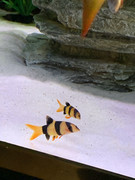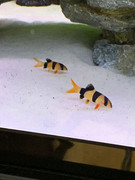Page 1 of 1
Different growth rate in the “teensy” clowns
Posted: Sun Feb 03, 2019 10:55 am
by FranM
Now that the smaller of the two clowns is much more confident being out and about, clearly he’s growing at a much slower pace.
I noticed yesterday he was flashing a little and today it’s a bit more, so I’m going to dose with Prazipro.
Here are the side by side comparisons:


Re: Different growth rate in the “teensy” clowns
Posted: Sun Feb 03, 2019 3:18 pm
by Loachloach
Clown loaches grow at different rates.
From the first group of 5 I bought 7 years ago there is now 5 inch difference between the largest and the smallest from the same group.
It is never a good idea to over-medicate your fish. I think you've dosed those fish way too many times now. Mine didn't see meds for the first 5 years and then after that I've dosed them 2-3 times, for a 7 year period.
Re: Different growth rate in the “teensy” clowns
Posted: Sun Feb 03, 2019 9:21 pm
by FranM
Prazipro is safe and can be used as a preventative. I’m using it as both right now. I see a problem that I don’t want to get out of control. Kusuri can be used monthly as well and is also safe. I don’t, however, use either as a prophylactic. So, no, I don’t think I’m overmedicating.
Re: Different growth rate in the “teensy” clowns
Posted: Tue Feb 05, 2019 3:06 pm
by Loachloach
I am not sure where you're getting your info about the frequency of dosing but it sounds incorrect.
Generally, if you have de-wormed your fish once, they only need to be de-wormed again if you have introduced new un-quarantined fish, and it is more of a preventative to protect your old fish. After that there is no need to teat your fish again, and from what I can recall, prazi is not safe at all to overuse. Flubendazole can be used once a year, again providing you're introducing new fish/contaminants.
If you are seeing recurring issues,providing you have not introduced new stock, the problem lies in the tank set up, water quality, etc..and it is not a disease but immune system failure. Meds make it worse as they interfere with the biofilm diversity.
If you have not de-wormed the baby loaches already, I am inclined to agree it is a good idea to do so. However, that should have been done in quarantine, separately from the other fish which you had treated numerous times in the past. It can be a bit too much for them and instead of helping, you could be harming them, leading to an avalanche of more problems.
Prazi is active for about 3-4 weeks after the tank is dosed and one should not treat with a different med within that time frame afterwards, in case you are planning on flubendazole again.
What issues exactly are you observing besides different growth rate?
Re: Different growth rate in the “teensy” clowns
Posted: Tue Feb 05, 2019 4:56 pm
by FranM
One of the teensies, the smaller one, was flashing. I had done a regularly scheduled water change and he flashed that day. I waited, and he flashed more the next day. So I Praziproed. I don’t remember if I did a Kusuri dose with the teensies. I don’t think I did. I did after I transferred the tank inhabitants to the new tank.
All the information I recited came right of the product directions. And again, I don’t dose to dose.
Re: Different growth rate in the “teensy” clowns
Posted: Tue Feb 05, 2019 8:23 pm
by NancyD
I wonder if the big size difference is just a sex/size issue. Males grow much slower, females faster. When I grew out small clowns the females were close to 50% larger after a year or so.
I agree with LL, if your fish were well dosed for worms in QT, you don't need to keep doing it. Drugs are not without possible side effects & some individual fish are more sensitive than others.
Re: Different growth rate in the “teensy” clowns
Posted: Wed Feb 06, 2019 6:10 am
by FranM
I like your thought about the males vs females growth rate. The smaller teensy took the longest to settle in, too.
They were not quarantined—it was the plop in and pray method. I didn’t add an ich med or anything. In fact I just read my notes to confirm that. They were added 11/3.
The good news is my observations have shown no signs of flashing since I added Prazipro. I don’t know why this happened. I did try my best to remove a top layer of sand the day of the water change. Maybe the moving sand was an irritant.
Re: Different growth rate in the “teensy” clowns
Posted: Fri Feb 08, 2019 7:46 pm
by Loachloach
Hey Fran.
Someone may have better explanation but from my personal experience with clown loaches, they do actually tend to flash from time to time without actually being sick. It is something I have noticed over the years that used to bother me at the start. I have theories that at times it is indeed due to water quality, TDS changes in particular, when tank water is gone awry and one does a larg-ish water change, which I normally do.... But at other times I think it is something to do with dominance as well, based on my 7 years observations.
I've seen my largest ones flash just right in the middle of the bunch, then another clown will follow, then another, like a chain effect. I've learned to do nothing at all, no meds, no panic, and here we go they're alive in my tank for 7 years. They have quite complex social structure from what I gather and your clowns are still "establishing" who is who....The flashing could be related. If not that, first line of defense is more water changes. It is the basis of clown loach health.
Also from my personal view, clown loaches are really tough. I haven't had as much as a split fin over all the years I've kept them. Don't worry, don't panic, wait and see before you act. It is a good idea you treat the young clowns with flubendazole, if you haven't already. After that stop for a good while and just enjoy your fish.
Re: Different growth rate in the “teensy” clowns
Posted: Fri Feb 08, 2019 7:56 pm
by FranM
Thanks, Loach.
I did wait a day. Next time I will wait longer. But because it’s so small I was afraid something could go bad fast! What if it had the beginnings of flukes? A tiny little body like that could be overtaken fast.
I usually do a 40 to 50% water change when I notice the nitrates creeping above 20 ppm.
Re: Different growth rate in the “teensy” clowns
Posted: Sat Feb 09, 2019 7:18 am
by redshark1
Just to add the reassurance that I have not medicated my fish at all in the last 24 years.
I have never dewormed them for example.
I only add the correct dosage of prime at water change time, that is all.